Wireless Network Security and Preventive Techniques Analysis Report
VerifiedAdded on 2021/05/30
|14
|3699
|37
Report
AI Summary
This report provides a comprehensive analysis of wireless network security and preventive techniques. It begins with an abstract and introduction, highlighting the growing importance of wireless networks and the associated security threats. The literature review covers the technologies used for wireless network security, including SSID hiding, MAC ID filtering, static IP addressing, 802.11 security, restricted access networks, and WAPI. The applications and effectiveness of each technology are discussed. The report also addresses the challenges and problems associated with wireless network security, such as cyberattacks, misconfigurations, and limited knowledge. Future research directions are explored, followed by a conclusion summarizing the key findings. The report emphasizes the need for robust security measures to protect against unauthorized access and data breaches in wireless networks. The student report provides a thorough overview of the subject, making it a valuable resource for understanding the complexities of wireless network security.
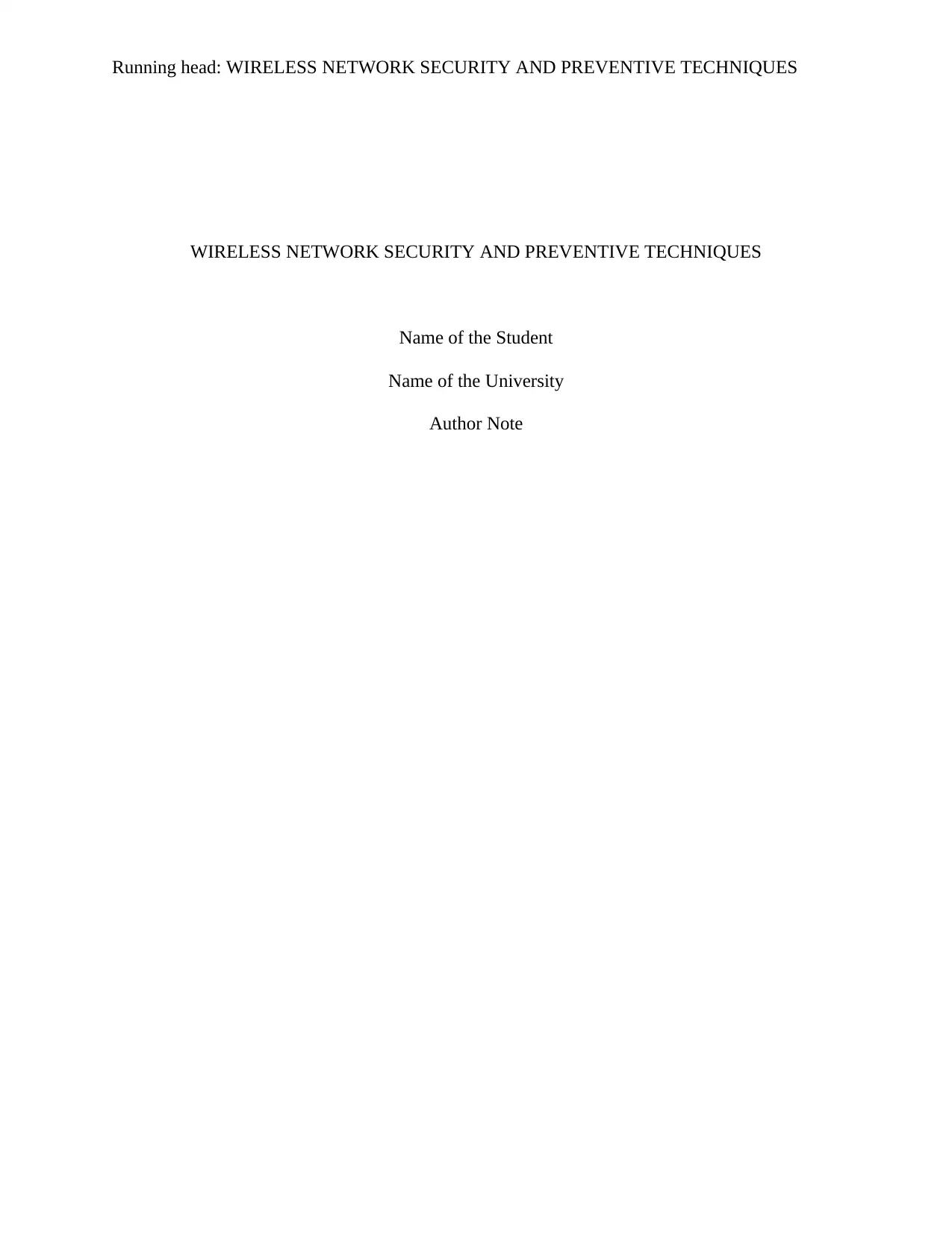
Running head: WIRELESS NETWORK SECURITY AND PREVENTIVE TECHNIQUES
WIRELESS NETWORK SECURITY AND PREVENTIVE TECHNIQUES
Name of the Student
Name of the University
Author Note
WIRELESS NETWORK SECURITY AND PREVENTIVE TECHNIQUES
Name of the Student
Name of the University
Author Note
Paraphrase This Document
Need a fresh take? Get an instant paraphrase of this document with our AI Paraphraser
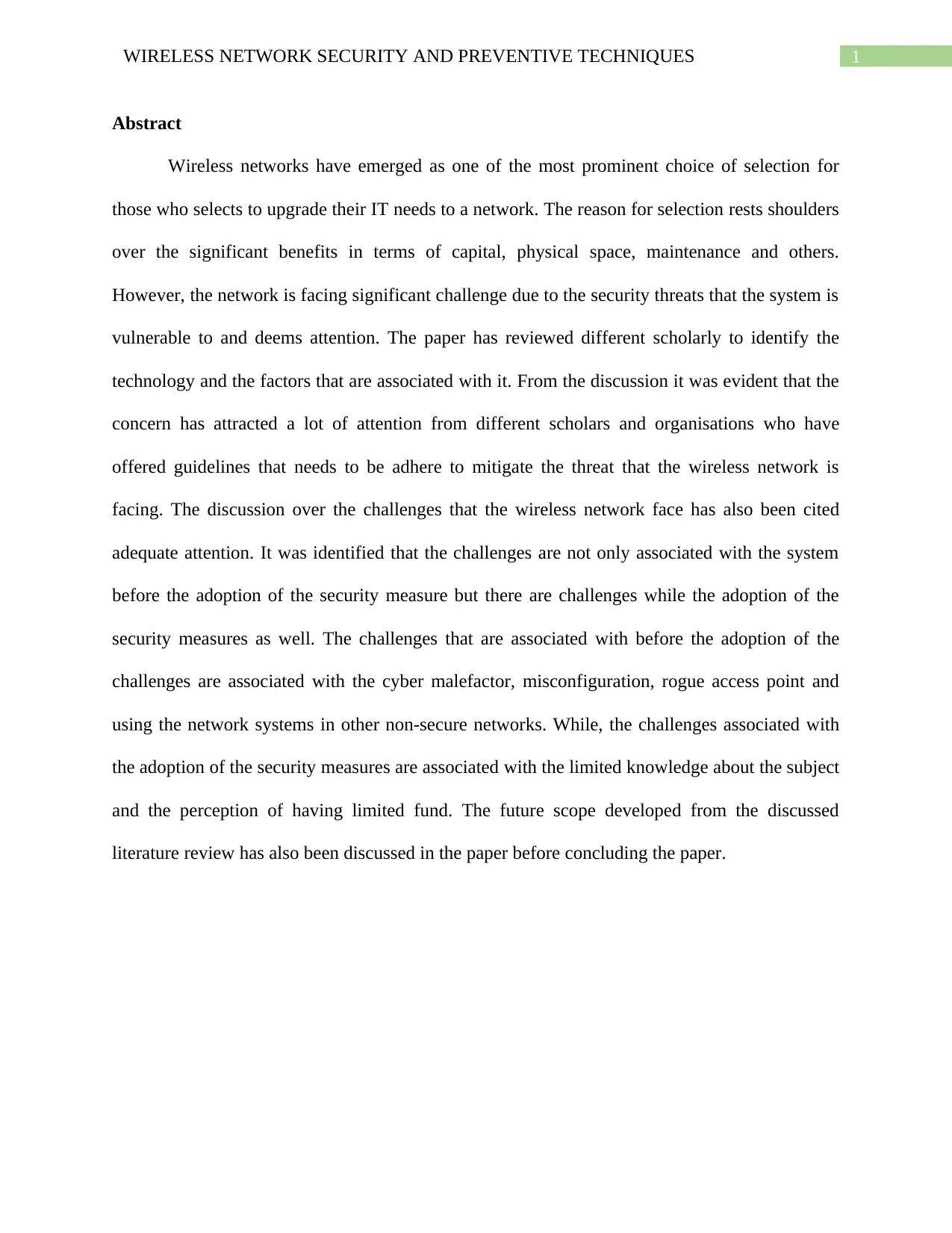
1WIRELESS NETWORK SECURITY AND PREVENTIVE TECHNIQUES
Abstract
Wireless networks have emerged as one of the most prominent choice of selection for
those who selects to upgrade their IT needs to a network. The reason for selection rests shoulders
over the significant benefits in terms of capital, physical space, maintenance and others.
However, the network is facing significant challenge due to the security threats that the system is
vulnerable to and deems attention. The paper has reviewed different scholarly to identify the
technology and the factors that are associated with it. From the discussion it was evident that the
concern has attracted a lot of attention from different scholars and organisations who have
offered guidelines that needs to be adhere to mitigate the threat that the wireless network is
facing. The discussion over the challenges that the wireless network face has also been cited
adequate attention. It was identified that the challenges are not only associated with the system
before the adoption of the security measure but there are challenges while the adoption of the
security measures as well. The challenges that are associated with before the adoption of the
challenges are associated with the cyber malefactor, misconfiguration, rogue access point and
using the network systems in other non-secure networks. While, the challenges associated with
the adoption of the security measures are associated with the limited knowledge about the subject
and the perception of having limited fund. The future scope developed from the discussed
literature review has also been discussed in the paper before concluding the paper.
Abstract
Wireless networks have emerged as one of the most prominent choice of selection for
those who selects to upgrade their IT needs to a network. The reason for selection rests shoulders
over the significant benefits in terms of capital, physical space, maintenance and others.
However, the network is facing significant challenge due to the security threats that the system is
vulnerable to and deems attention. The paper has reviewed different scholarly to identify the
technology and the factors that are associated with it. From the discussion it was evident that the
concern has attracted a lot of attention from different scholars and organisations who have
offered guidelines that needs to be adhere to mitigate the threat that the wireless network is
facing. The discussion over the challenges that the wireless network face has also been cited
adequate attention. It was identified that the challenges are not only associated with the system
before the adoption of the security measure but there are challenges while the adoption of the
security measures as well. The challenges that are associated with before the adoption of the
challenges are associated with the cyber malefactor, misconfiguration, rogue access point and
using the network systems in other non-secure networks. While, the challenges associated with
the adoption of the security measures are associated with the limited knowledge about the subject
and the perception of having limited fund. The future scope developed from the discussed
literature review has also been discussed in the paper before concluding the paper.
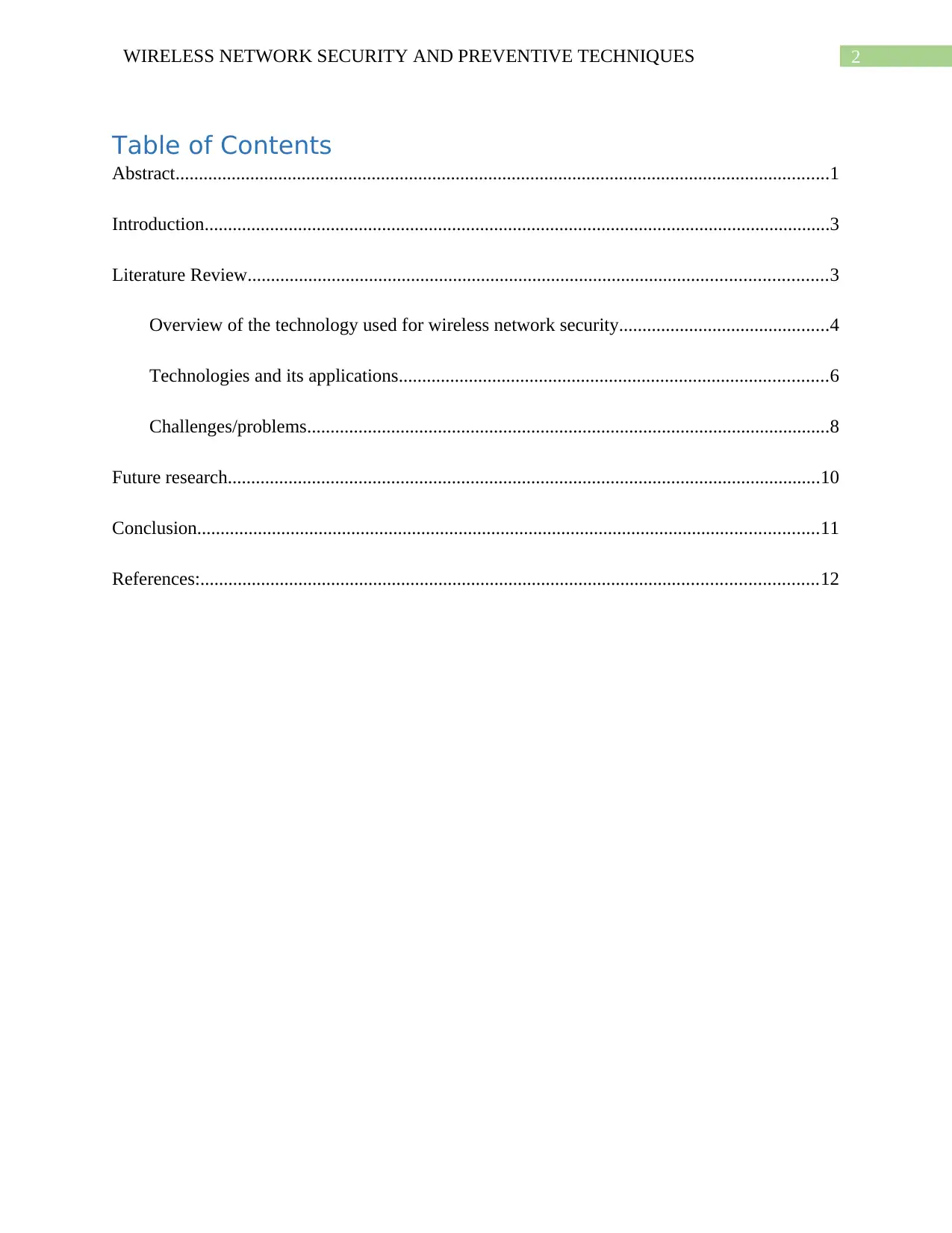
2WIRELESS NETWORK SECURITY AND PREVENTIVE TECHNIQUES
Table of Contents
Abstract............................................................................................................................................1
Introduction......................................................................................................................................3
Literature Review............................................................................................................................3
Overview of the technology used for wireless network security.............................................4
Technologies and its applications............................................................................................6
Challenges/problems................................................................................................................8
Future research...............................................................................................................................10
Conclusion.....................................................................................................................................11
References:....................................................................................................................................12
Table of Contents
Abstract............................................................................................................................................1
Introduction......................................................................................................................................3
Literature Review............................................................................................................................3
Overview of the technology used for wireless network security.............................................4
Technologies and its applications............................................................................................6
Challenges/problems................................................................................................................8
Future research...............................................................................................................................10
Conclusion.....................................................................................................................................11
References:....................................................................................................................................12
⊘ This is a preview!⊘
Do you want full access?
Subscribe today to unlock all pages.

Trusted by 1+ million students worldwide
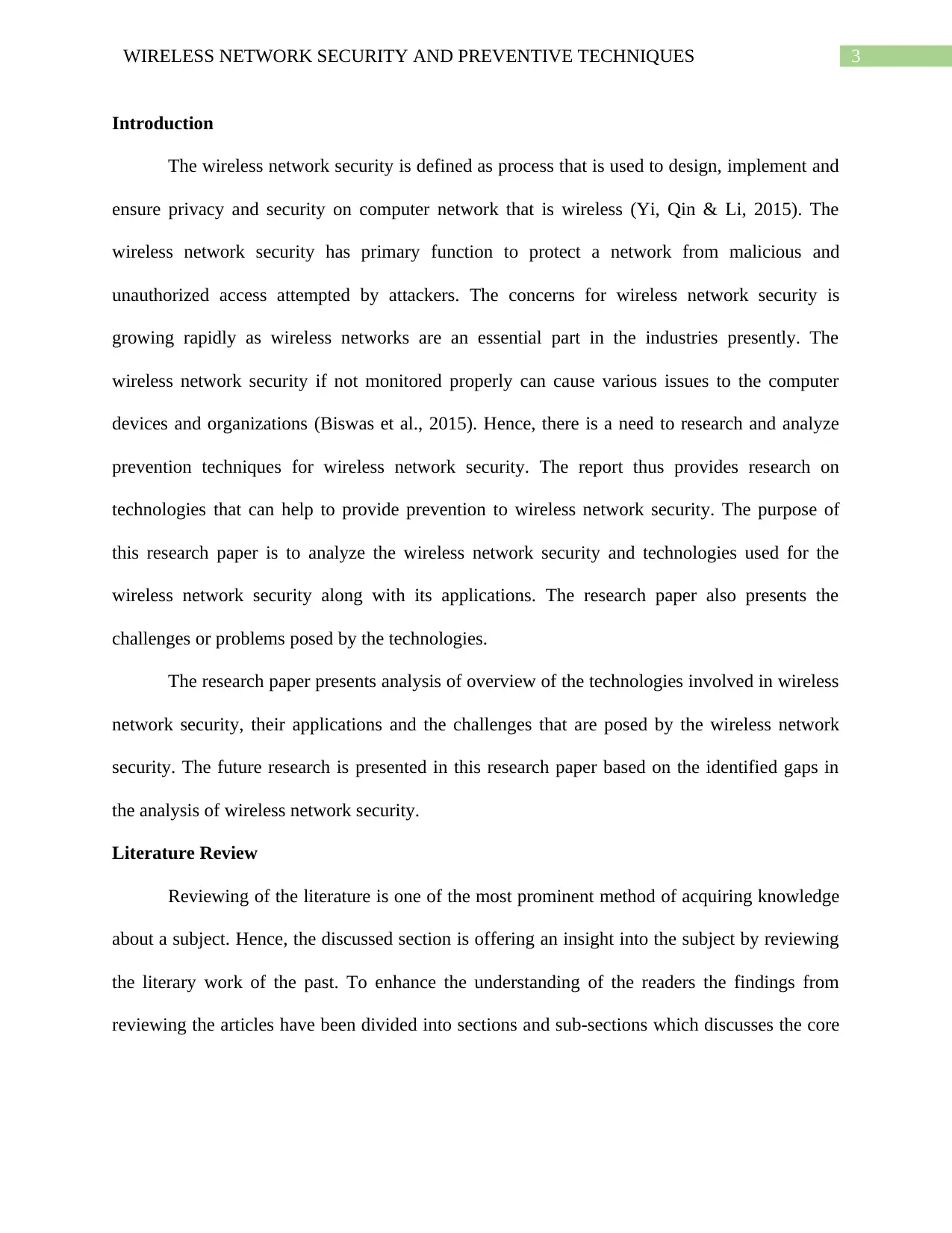
3WIRELESS NETWORK SECURITY AND PREVENTIVE TECHNIQUES
Introduction
The wireless network security is defined as process that is used to design, implement and
ensure privacy and security on computer network that is wireless (Yi, Qin & Li, 2015). The
wireless network security has primary function to protect a network from malicious and
unauthorized access attempted by attackers. The concerns for wireless network security is
growing rapidly as wireless networks are an essential part in the industries presently. The
wireless network security if not monitored properly can cause various issues to the computer
devices and organizations (Biswas et al., 2015). Hence, there is a need to research and analyze
prevention techniques for wireless network security. The report thus provides research on
technologies that can help to provide prevention to wireless network security. The purpose of
this research paper is to analyze the wireless network security and technologies used for the
wireless network security along with its applications. The research paper also presents the
challenges or problems posed by the technologies.
The research paper presents analysis of overview of the technologies involved in wireless
network security, their applications and the challenges that are posed by the wireless network
security. The future research is presented in this research paper based on the identified gaps in
the analysis of wireless network security.
Literature Review
Reviewing of the literature is one of the most prominent method of acquiring knowledge
about a subject. Hence, the discussed section is offering an insight into the subject by reviewing
the literary work of the past. To enhance the understanding of the readers the findings from
reviewing the articles have been divided into sections and sub-sections which discusses the core
Introduction
The wireless network security is defined as process that is used to design, implement and
ensure privacy and security on computer network that is wireless (Yi, Qin & Li, 2015). The
wireless network security has primary function to protect a network from malicious and
unauthorized access attempted by attackers. The concerns for wireless network security is
growing rapidly as wireless networks are an essential part in the industries presently. The
wireless network security if not monitored properly can cause various issues to the computer
devices and organizations (Biswas et al., 2015). Hence, there is a need to research and analyze
prevention techniques for wireless network security. The report thus provides research on
technologies that can help to provide prevention to wireless network security. The purpose of
this research paper is to analyze the wireless network security and technologies used for the
wireless network security along with its applications. The research paper also presents the
challenges or problems posed by the technologies.
The research paper presents analysis of overview of the technologies involved in wireless
network security, their applications and the challenges that are posed by the wireless network
security. The future research is presented in this research paper based on the identified gaps in
the analysis of wireless network security.
Literature Review
Reviewing of the literature is one of the most prominent method of acquiring knowledge
about a subject. Hence, the discussed section is offering an insight into the subject by reviewing
the literary work of the past. To enhance the understanding of the readers the findings from
reviewing the articles have been divided into sections and sub-sections which discusses the core
Paraphrase This Document
Need a fresh take? Get an instant paraphrase of this document with our AI Paraphraser
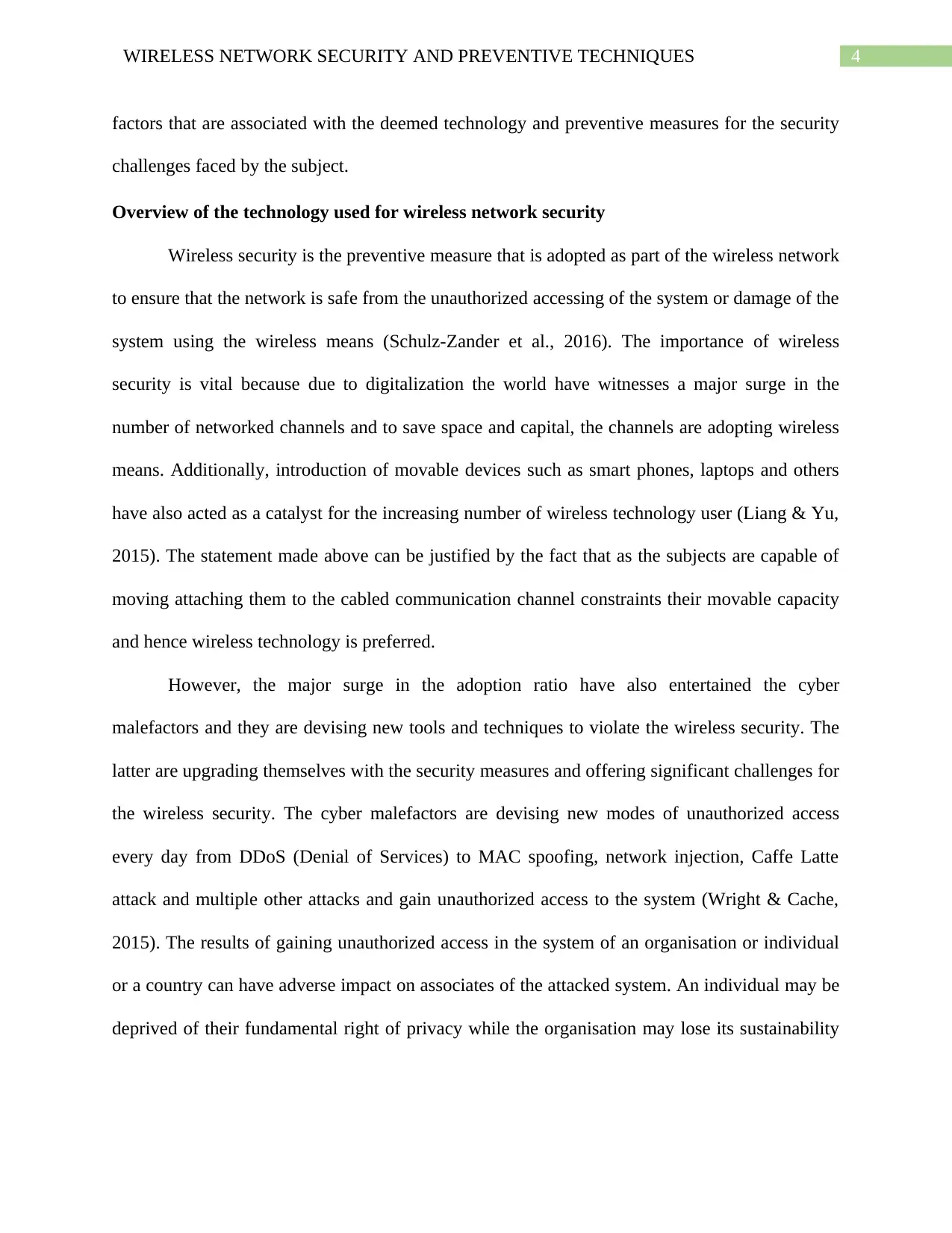
4WIRELESS NETWORK SECURITY AND PREVENTIVE TECHNIQUES
factors that are associated with the deemed technology and preventive measures for the security
challenges faced by the subject.
Overview of the technology used for wireless network security
Wireless security is the preventive measure that is adopted as part of the wireless network
to ensure that the network is safe from the unauthorized accessing of the system or damage of the
system using the wireless means (Schulz-Zander et al., 2016). The importance of wireless
security is vital because due to digitalization the world have witnesses a major surge in the
number of networked channels and to save space and capital, the channels are adopting wireless
means. Additionally, introduction of movable devices such as smart phones, laptops and others
have also acted as a catalyst for the increasing number of wireless technology user (Liang & Yu,
2015). The statement made above can be justified by the fact that as the subjects are capable of
moving attaching them to the cabled communication channel constraints their movable capacity
and hence wireless technology is preferred.
However, the major surge in the adoption ratio have also entertained the cyber
malefactors and they are devising new tools and techniques to violate the wireless security. The
latter are upgrading themselves with the security measures and offering significant challenges for
the wireless security. The cyber malefactors are devising new modes of unauthorized access
every day from DDoS (Denial of Services) to MAC spoofing, network injection, Caffe Latte
attack and multiple other attacks and gain unauthorized access to the system (Wright & Cache,
2015). The results of gaining unauthorized access in the system of an organisation or individual
or a country can have adverse impact on associates of the attacked system. An individual may be
deprived of their fundamental right of privacy while the organisation may lose its sustainability
factors that are associated with the deemed technology and preventive measures for the security
challenges faced by the subject.
Overview of the technology used for wireless network security
Wireless security is the preventive measure that is adopted as part of the wireless network
to ensure that the network is safe from the unauthorized accessing of the system or damage of the
system using the wireless means (Schulz-Zander et al., 2016). The importance of wireless
security is vital because due to digitalization the world have witnesses a major surge in the
number of networked channels and to save space and capital, the channels are adopting wireless
means. Additionally, introduction of movable devices such as smart phones, laptops and others
have also acted as a catalyst for the increasing number of wireless technology user (Liang & Yu,
2015). The statement made above can be justified by the fact that as the subjects are capable of
moving attaching them to the cabled communication channel constraints their movable capacity
and hence wireless technology is preferred.
However, the major surge in the adoption ratio have also entertained the cyber
malefactors and they are devising new tools and techniques to violate the wireless security. The
latter are upgrading themselves with the security measures and offering significant challenges for
the wireless security. The cyber malefactors are devising new modes of unauthorized access
every day from DDoS (Denial of Services) to MAC spoofing, network injection, Caffe Latte
attack and multiple other attacks and gain unauthorized access to the system (Wright & Cache,
2015). The results of gaining unauthorized access in the system of an organisation or individual
or a country can have adverse impact on associates of the attacked system. An individual may be
deprived of their fundamental right of privacy while the organisation may lose its sustainability
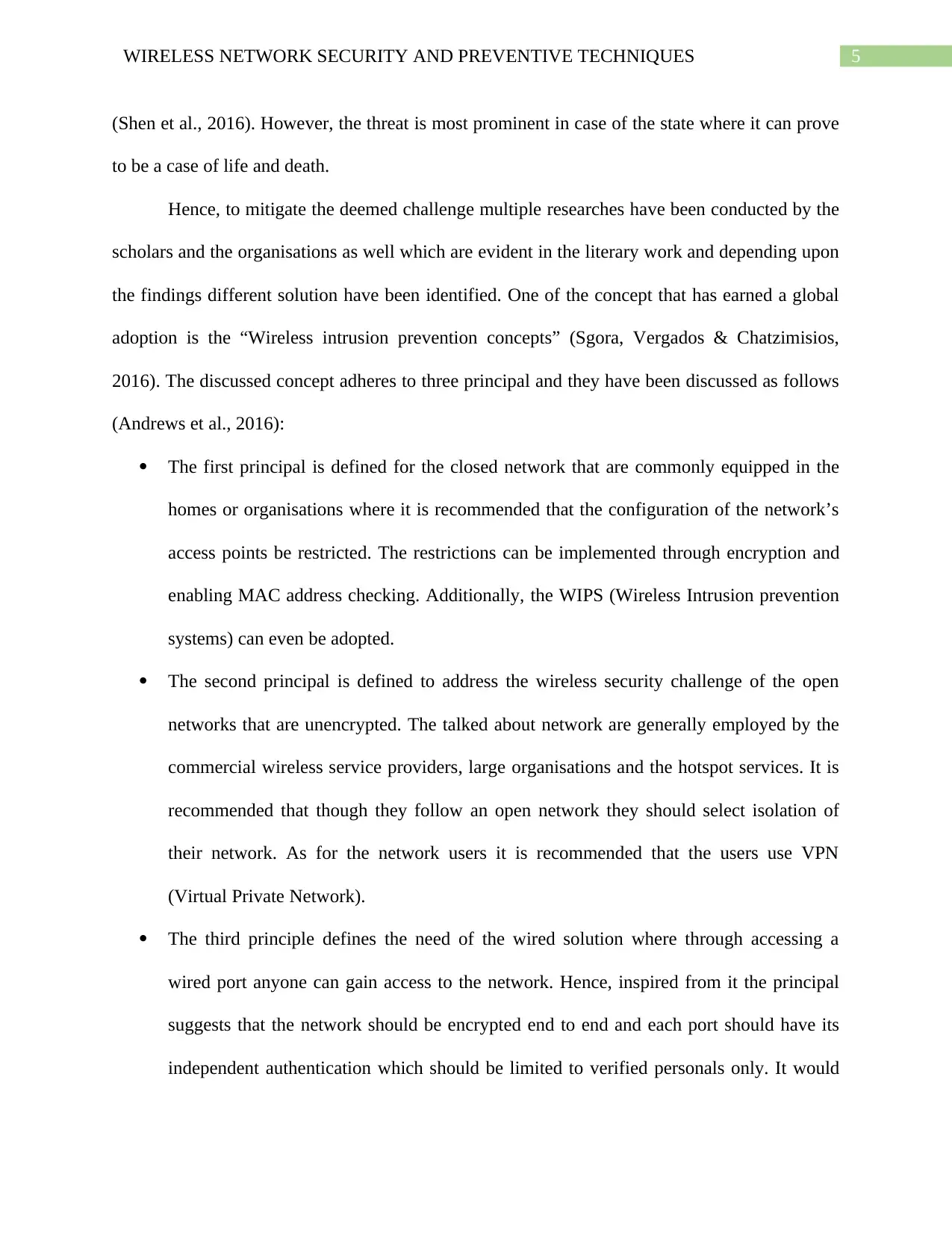
5WIRELESS NETWORK SECURITY AND PREVENTIVE TECHNIQUES
(Shen et al., 2016). However, the threat is most prominent in case of the state where it can prove
to be a case of life and death.
Hence, to mitigate the deemed challenge multiple researches have been conducted by the
scholars and the organisations as well which are evident in the literary work and depending upon
the findings different solution have been identified. One of the concept that has earned a global
adoption is the “Wireless intrusion prevention concepts” (Sgora, Vergados & Chatzimisios,
2016). The discussed concept adheres to three principal and they have been discussed as follows
(Andrews et al., 2016):
The first principal is defined for the closed network that are commonly equipped in the
homes or organisations where it is recommended that the configuration of the network’s
access points be restricted. The restrictions can be implemented through encryption and
enabling MAC address checking. Additionally, the WIPS (Wireless Intrusion prevention
systems) can even be adopted.
The second principal is defined to address the wireless security challenge of the open
networks that are unencrypted. The talked about network are generally employed by the
commercial wireless service providers, large organisations and the hotspot services. It is
recommended that though they follow an open network they should select isolation of
their network. As for the network users it is recommended that the users use VPN
(Virtual Private Network).
The third principle defines the need of the wired solution where through accessing a
wired port anyone can gain access to the network. Hence, inspired from it the principal
suggests that the network should be encrypted end to end and each port should have its
independent authentication which should be limited to verified personals only. It would
(Shen et al., 2016). However, the threat is most prominent in case of the state where it can prove
to be a case of life and death.
Hence, to mitigate the deemed challenge multiple researches have been conducted by the
scholars and the organisations as well which are evident in the literary work and depending upon
the findings different solution have been identified. One of the concept that has earned a global
adoption is the “Wireless intrusion prevention concepts” (Sgora, Vergados & Chatzimisios,
2016). The discussed concept adheres to three principal and they have been discussed as follows
(Andrews et al., 2016):
The first principal is defined for the closed network that are commonly equipped in the
homes or organisations where it is recommended that the configuration of the network’s
access points be restricted. The restrictions can be implemented through encryption and
enabling MAC address checking. Additionally, the WIPS (Wireless Intrusion prevention
systems) can even be adopted.
The second principal is defined to address the wireless security challenge of the open
networks that are unencrypted. The talked about network are generally employed by the
commercial wireless service providers, large organisations and the hotspot services. It is
recommended that though they follow an open network they should select isolation of
their network. As for the network users it is recommended that the users use VPN
(Virtual Private Network).
The third principle defines the need of the wired solution where through accessing a
wired port anyone can gain access to the network. Hence, inspired from it the principal
suggests that the network should be encrypted end to end and each port should have its
independent authentication which should be limited to verified personals only. It would
⊘ This is a preview!⊘
Do you want full access?
Subscribe today to unlock all pages.

Trusted by 1+ million students worldwide
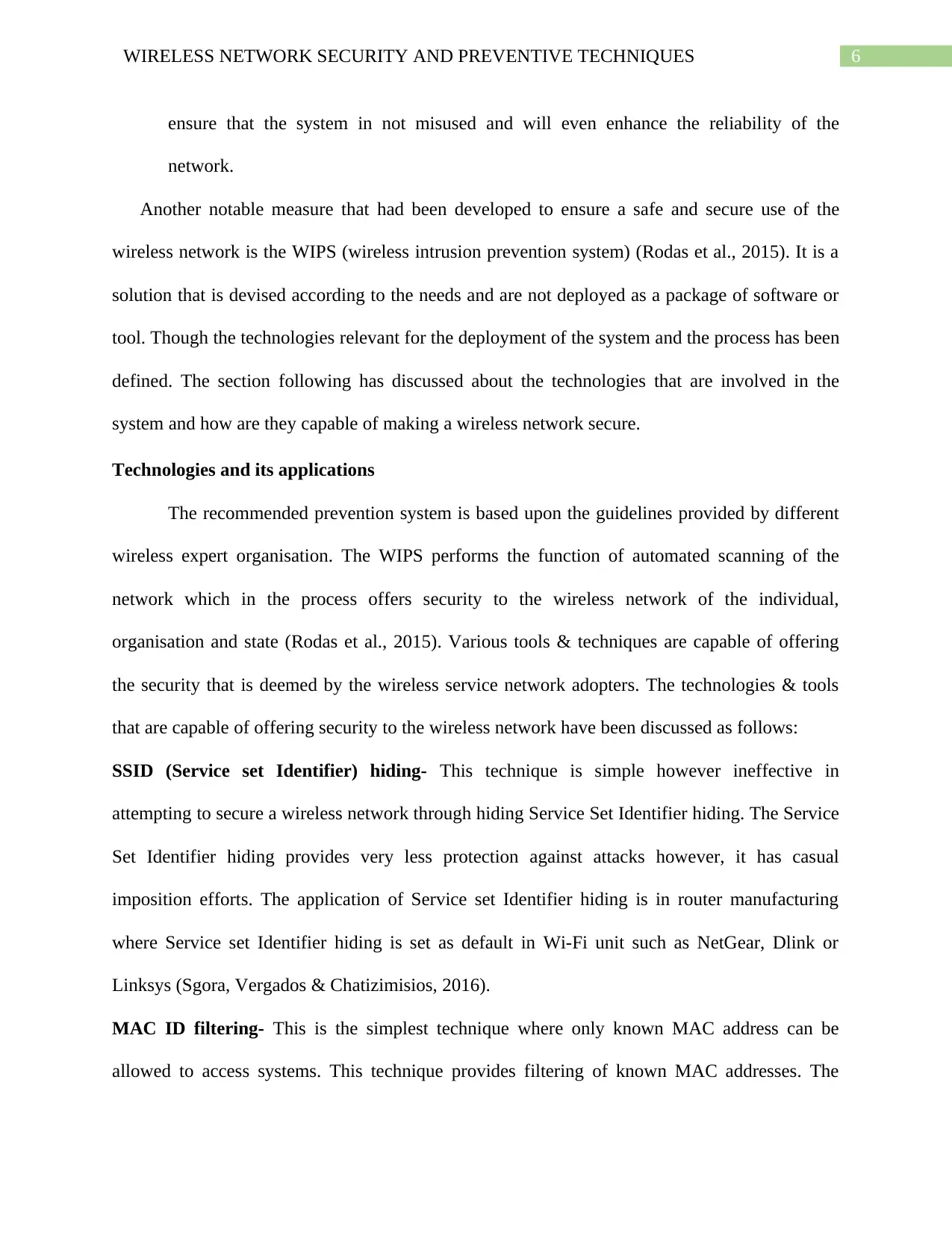
6WIRELESS NETWORK SECURITY AND PREVENTIVE TECHNIQUES
ensure that the system in not misused and will even enhance the reliability of the
network.
Another notable measure that had been developed to ensure a safe and secure use of the
wireless network is the WIPS (wireless intrusion prevention system) (Rodas et al., 2015). It is a
solution that is devised according to the needs and are not deployed as a package of software or
tool. Though the technologies relevant for the deployment of the system and the process has been
defined. The section following has discussed about the technologies that are involved in the
system and how are they capable of making a wireless network secure.
Technologies and its applications
The recommended prevention system is based upon the guidelines provided by different
wireless expert organisation. The WIPS performs the function of automated scanning of the
network which in the process offers security to the wireless network of the individual,
organisation and state (Rodas et al., 2015). Various tools & techniques are capable of offering
the security that is deemed by the wireless service network adopters. The technologies & tools
that are capable of offering security to the wireless network have been discussed as follows:
SSID (Service set Identifier) hiding- This technique is simple however ineffective in
attempting to secure a wireless network through hiding Service Set Identifier hiding. The Service
Set Identifier hiding provides very less protection against attacks however, it has casual
imposition efforts. The application of Service set Identifier hiding is in router manufacturing
where Service set Identifier hiding is set as default in Wi-Fi unit such as NetGear, Dlink or
Linksys (Sgora, Vergados & Chatizimisios, 2016).
MAC ID filtering- This is the simplest technique where only known MAC address can be
allowed to access systems. This technique provides filtering of known MAC addresses. The
ensure that the system in not misused and will even enhance the reliability of the
network.
Another notable measure that had been developed to ensure a safe and secure use of the
wireless network is the WIPS (wireless intrusion prevention system) (Rodas et al., 2015). It is a
solution that is devised according to the needs and are not deployed as a package of software or
tool. Though the technologies relevant for the deployment of the system and the process has been
defined. The section following has discussed about the technologies that are involved in the
system and how are they capable of making a wireless network secure.
Technologies and its applications
The recommended prevention system is based upon the guidelines provided by different
wireless expert organisation. The WIPS performs the function of automated scanning of the
network which in the process offers security to the wireless network of the individual,
organisation and state (Rodas et al., 2015). Various tools & techniques are capable of offering
the security that is deemed by the wireless service network adopters. The technologies & tools
that are capable of offering security to the wireless network have been discussed as follows:
SSID (Service set Identifier) hiding- This technique is simple however ineffective in
attempting to secure a wireless network through hiding Service Set Identifier hiding. The Service
Set Identifier hiding provides very less protection against attacks however, it has casual
imposition efforts. The application of Service set Identifier hiding is in router manufacturing
where Service set Identifier hiding is set as default in Wi-Fi unit such as NetGear, Dlink or
Linksys (Sgora, Vergados & Chatizimisios, 2016).
MAC ID filtering- This is the simplest technique where only known MAC address can be
allowed to access systems. This technique provides filtering of known MAC addresses. The
Paraphrase This Document
Need a fresh take? Get an instant paraphrase of this document with our AI Paraphraser
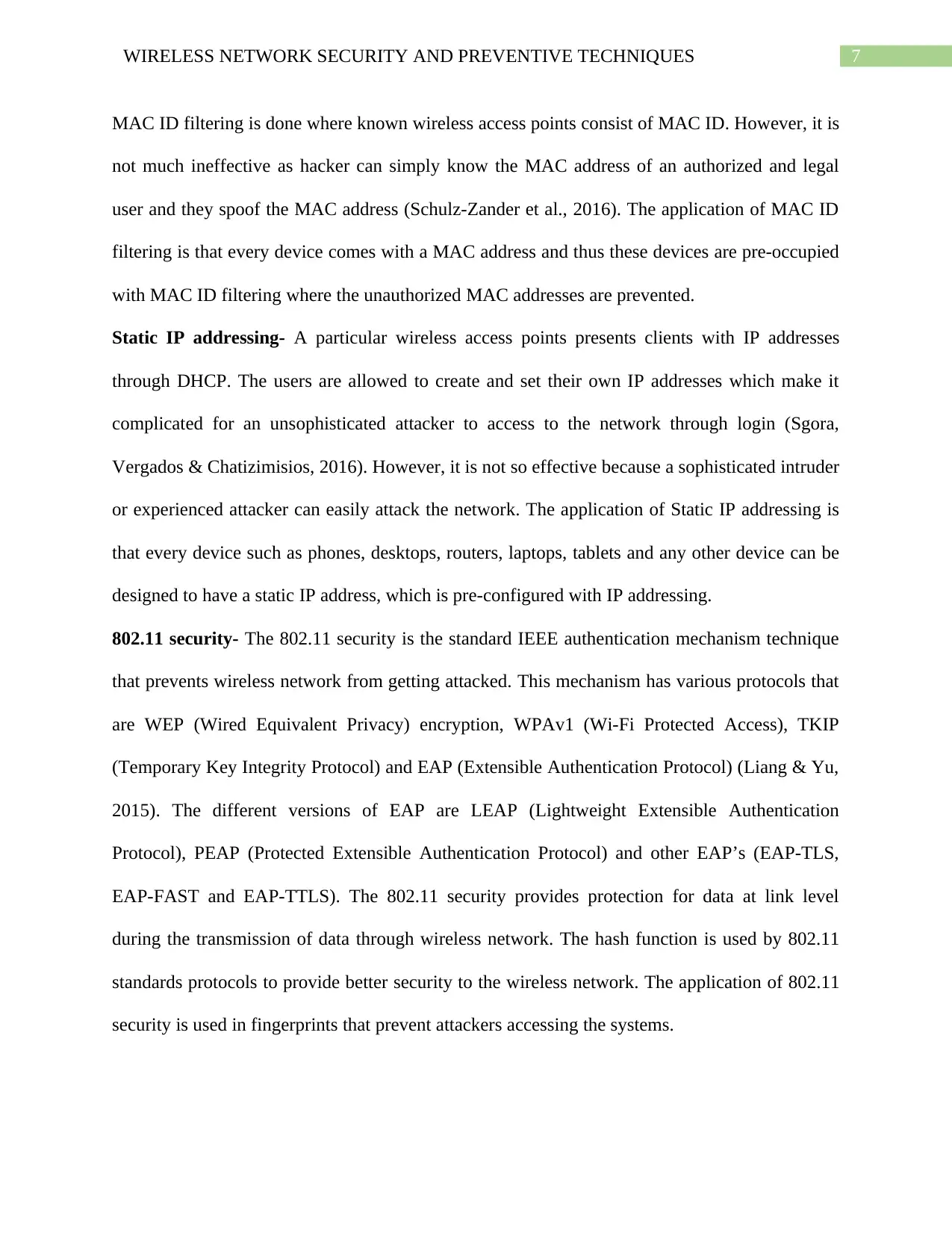
7WIRELESS NETWORK SECURITY AND PREVENTIVE TECHNIQUES
MAC ID filtering is done where known wireless access points consist of MAC ID. However, it is
not much ineffective as hacker can simply know the MAC address of an authorized and legal
user and they spoof the MAC address (Schulz-Zander et al., 2016). The application of MAC ID
filtering is that every device comes with a MAC address and thus these devices are pre-occupied
with MAC ID filtering where the unauthorized MAC addresses are prevented.
Static IP addressing- A particular wireless access points presents clients with IP addresses
through DHCP. The users are allowed to create and set their own IP addresses which make it
complicated for an unsophisticated attacker to access to the network through login (Sgora,
Vergados & Chatizimisios, 2016). However, it is not so effective because a sophisticated intruder
or experienced attacker can easily attack the network. The application of Static IP addressing is
that every device such as phones, desktops, routers, laptops, tablets and any other device can be
designed to have a static IP address, which is pre-configured with IP addressing.
802.11 security- The 802.11 security is the standard IEEE authentication mechanism technique
that prevents wireless network from getting attacked. This mechanism has various protocols that
are WEP (Wired Equivalent Privacy) encryption, WPAv1 (Wi-Fi Protected Access), TKIP
(Temporary Key Integrity Protocol) and EAP (Extensible Authentication Protocol) (Liang & Yu,
2015). The different versions of EAP are LEAP (Lightweight Extensible Authentication
Protocol), PEAP (Protected Extensible Authentication Protocol) and other EAP’s (EAP-TLS,
EAP-FAST and EAP-TTLS). The 802.11 security provides protection for data at link level
during the transmission of data through wireless network. The hash function is used by 802.11
standards protocols to provide better security to the wireless network. The application of 802.11
security is used in fingerprints that prevent attackers accessing the systems.
MAC ID filtering is done where known wireless access points consist of MAC ID. However, it is
not much ineffective as hacker can simply know the MAC address of an authorized and legal
user and they spoof the MAC address (Schulz-Zander et al., 2016). The application of MAC ID
filtering is that every device comes with a MAC address and thus these devices are pre-occupied
with MAC ID filtering where the unauthorized MAC addresses are prevented.
Static IP addressing- A particular wireless access points presents clients with IP addresses
through DHCP. The users are allowed to create and set their own IP addresses which make it
complicated for an unsophisticated attacker to access to the network through login (Sgora,
Vergados & Chatizimisios, 2016). However, it is not so effective because a sophisticated intruder
or experienced attacker can easily attack the network. The application of Static IP addressing is
that every device such as phones, desktops, routers, laptops, tablets and any other device can be
designed to have a static IP address, which is pre-configured with IP addressing.
802.11 security- The 802.11 security is the standard IEEE authentication mechanism technique
that prevents wireless network from getting attacked. This mechanism has various protocols that
are WEP (Wired Equivalent Privacy) encryption, WPAv1 (Wi-Fi Protected Access), TKIP
(Temporary Key Integrity Protocol) and EAP (Extensible Authentication Protocol) (Liang & Yu,
2015). The different versions of EAP are LEAP (Lightweight Extensible Authentication
Protocol), PEAP (Protected Extensible Authentication Protocol) and other EAP’s (EAP-TLS,
EAP-FAST and EAP-TTLS). The 802.11 security provides protection for data at link level
during the transmission of data through wireless network. The hash function is used by 802.11
standards protocols to provide better security to the wireless network. The application of 802.11
security is used in fingerprints that prevent attackers accessing the systems.
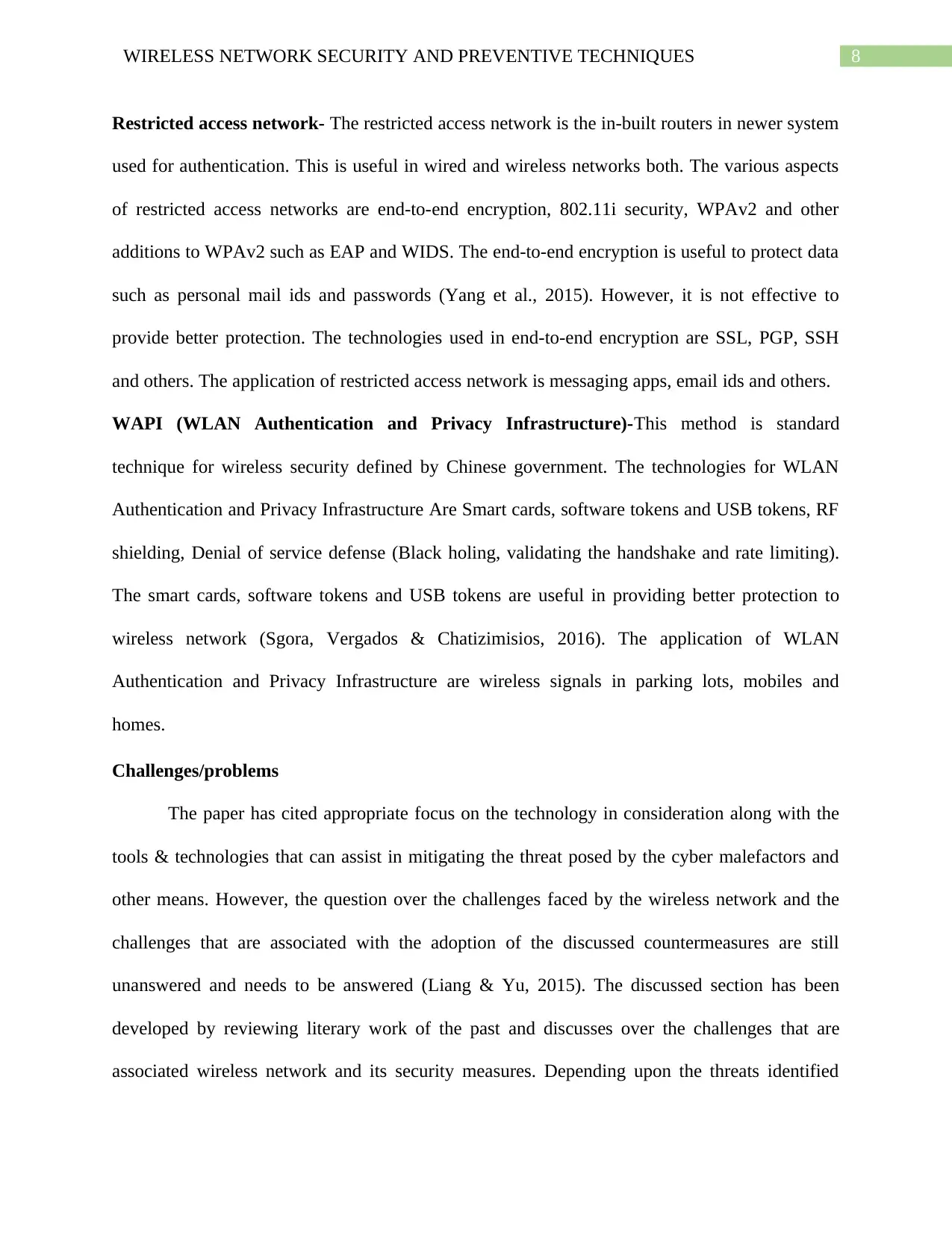
8WIRELESS NETWORK SECURITY AND PREVENTIVE TECHNIQUES
Restricted access network- The restricted access network is the in-built routers in newer system
used for authentication. This is useful in wired and wireless networks both. The various aspects
of restricted access networks are end-to-end encryption, 802.11i security, WPAv2 and other
additions to WPAv2 such as EAP and WIDS. The end-to-end encryption is useful to protect data
such as personal mail ids and passwords (Yang et al., 2015). However, it is not effective to
provide better protection. The technologies used in end-to-end encryption are SSL, PGP, SSH
and others. The application of restricted access network is messaging apps, email ids and others.
WAPI (WLAN Authentication and Privacy Infrastructure)-This method is standard
technique for wireless security defined by Chinese government. The technologies for WLAN
Authentication and Privacy Infrastructure Are Smart cards, software tokens and USB tokens, RF
shielding, Denial of service defense (Black holing, validating the handshake and rate limiting).
The smart cards, software tokens and USB tokens are useful in providing better protection to
wireless network (Sgora, Vergados & Chatizimisios, 2016). The application of WLAN
Authentication and Privacy Infrastructure are wireless signals in parking lots, mobiles and
homes.
Challenges/problems
The paper has cited appropriate focus on the technology in consideration along with the
tools & technologies that can assist in mitigating the threat posed by the cyber malefactors and
other means. However, the question over the challenges faced by the wireless network and the
challenges that are associated with the adoption of the discussed countermeasures are still
unanswered and needs to be answered (Liang & Yu, 2015). The discussed section has been
developed by reviewing literary work of the past and discusses over the challenges that are
associated wireless network and its security measures. Depending upon the threats identified
Restricted access network- The restricted access network is the in-built routers in newer system
used for authentication. This is useful in wired and wireless networks both. The various aspects
of restricted access networks are end-to-end encryption, 802.11i security, WPAv2 and other
additions to WPAv2 such as EAP and WIDS. The end-to-end encryption is useful to protect data
such as personal mail ids and passwords (Yang et al., 2015). However, it is not effective to
provide better protection. The technologies used in end-to-end encryption are SSL, PGP, SSH
and others. The application of restricted access network is messaging apps, email ids and others.
WAPI (WLAN Authentication and Privacy Infrastructure)-This method is standard
technique for wireless security defined by Chinese government. The technologies for WLAN
Authentication and Privacy Infrastructure Are Smart cards, software tokens and USB tokens, RF
shielding, Denial of service defense (Black holing, validating the handshake and rate limiting).
The smart cards, software tokens and USB tokens are useful in providing better protection to
wireless network (Sgora, Vergados & Chatizimisios, 2016). The application of WLAN
Authentication and Privacy Infrastructure are wireless signals in parking lots, mobiles and
homes.
Challenges/problems
The paper has cited appropriate focus on the technology in consideration along with the
tools & technologies that can assist in mitigating the threat posed by the cyber malefactors and
other means. However, the question over the challenges faced by the wireless network and the
challenges that are associated with the adoption of the discussed countermeasures are still
unanswered and needs to be answered (Liang & Yu, 2015). The discussed section has been
developed by reviewing literary work of the past and discusses over the challenges that are
associated wireless network and its security measures. Depending upon the threats identified
⊘ This is a preview!⊘
Do you want full access?
Subscribe today to unlock all pages.

Trusted by 1+ million students worldwide
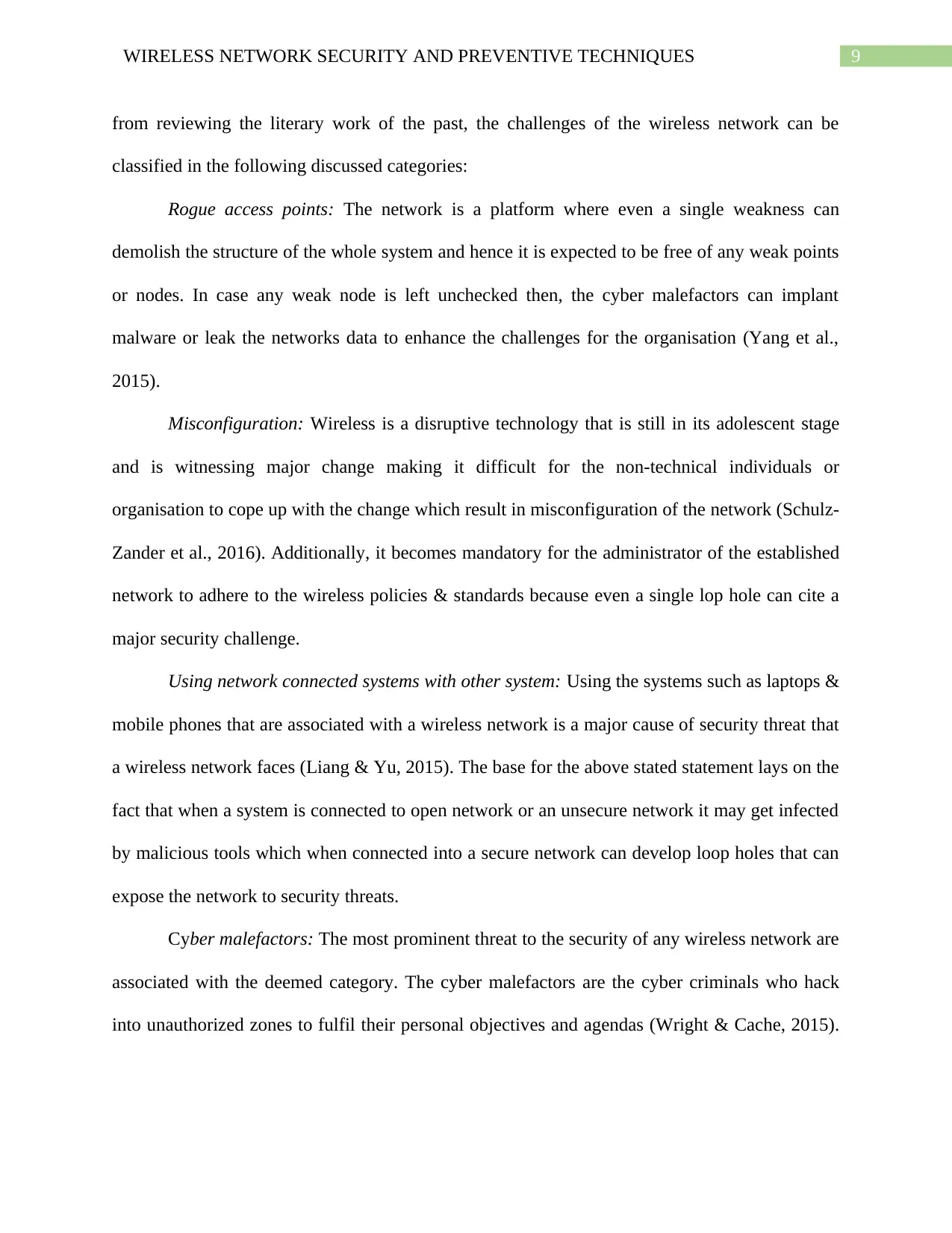
9WIRELESS NETWORK SECURITY AND PREVENTIVE TECHNIQUES
from reviewing the literary work of the past, the challenges of the wireless network can be
classified in the following discussed categories:
Rogue access points: The network is a platform where even a single weakness can
demolish the structure of the whole system and hence it is expected to be free of any weak points
or nodes. In case any weak node is left unchecked then, the cyber malefactors can implant
malware or leak the networks data to enhance the challenges for the organisation (Yang et al.,
2015).
Misconfiguration: Wireless is a disruptive technology that is still in its adolescent stage
and is witnessing major change making it difficult for the non-technical individuals or
organisation to cope up with the change which result in misconfiguration of the network (Schulz-
Zander et al., 2016). Additionally, it becomes mandatory for the administrator of the established
network to adhere to the wireless policies & standards because even a single lop hole can cite a
major security challenge.
Using network connected systems with other system: Using the systems such as laptops &
mobile phones that are associated with a wireless network is a major cause of security threat that
a wireless network faces (Liang & Yu, 2015). The base for the above stated statement lays on the
fact that when a system is connected to open network or an unsecure network it may get infected
by malicious tools which when connected into a secure network can develop loop holes that can
expose the network to security threats.
Cyber malefactors: The most prominent threat to the security of any wireless network are
associated with the deemed category. The cyber malefactors are the cyber criminals who hack
into unauthorized zones to fulfil their personal objectives and agendas (Wright & Cache, 2015).
from reviewing the literary work of the past, the challenges of the wireless network can be
classified in the following discussed categories:
Rogue access points: The network is a platform where even a single weakness can
demolish the structure of the whole system and hence it is expected to be free of any weak points
or nodes. In case any weak node is left unchecked then, the cyber malefactors can implant
malware or leak the networks data to enhance the challenges for the organisation (Yang et al.,
2015).
Misconfiguration: Wireless is a disruptive technology that is still in its adolescent stage
and is witnessing major change making it difficult for the non-technical individuals or
organisation to cope up with the change which result in misconfiguration of the network (Schulz-
Zander et al., 2016). Additionally, it becomes mandatory for the administrator of the established
network to adhere to the wireless policies & standards because even a single lop hole can cite a
major security challenge.
Using network connected systems with other system: Using the systems such as laptops &
mobile phones that are associated with a wireless network is a major cause of security threat that
a wireless network faces (Liang & Yu, 2015). The base for the above stated statement lays on the
fact that when a system is connected to open network or an unsecure network it may get infected
by malicious tools which when connected into a secure network can develop loop holes that can
expose the network to security threats.
Cyber malefactors: The most prominent threat to the security of any wireless network are
associated with the deemed category. The cyber malefactors are the cyber criminals who hack
into unauthorized zones to fulfil their personal objectives and agendas (Wright & Cache, 2015).
Paraphrase This Document
Need a fresh take? Get an instant paraphrase of this document with our AI Paraphraser
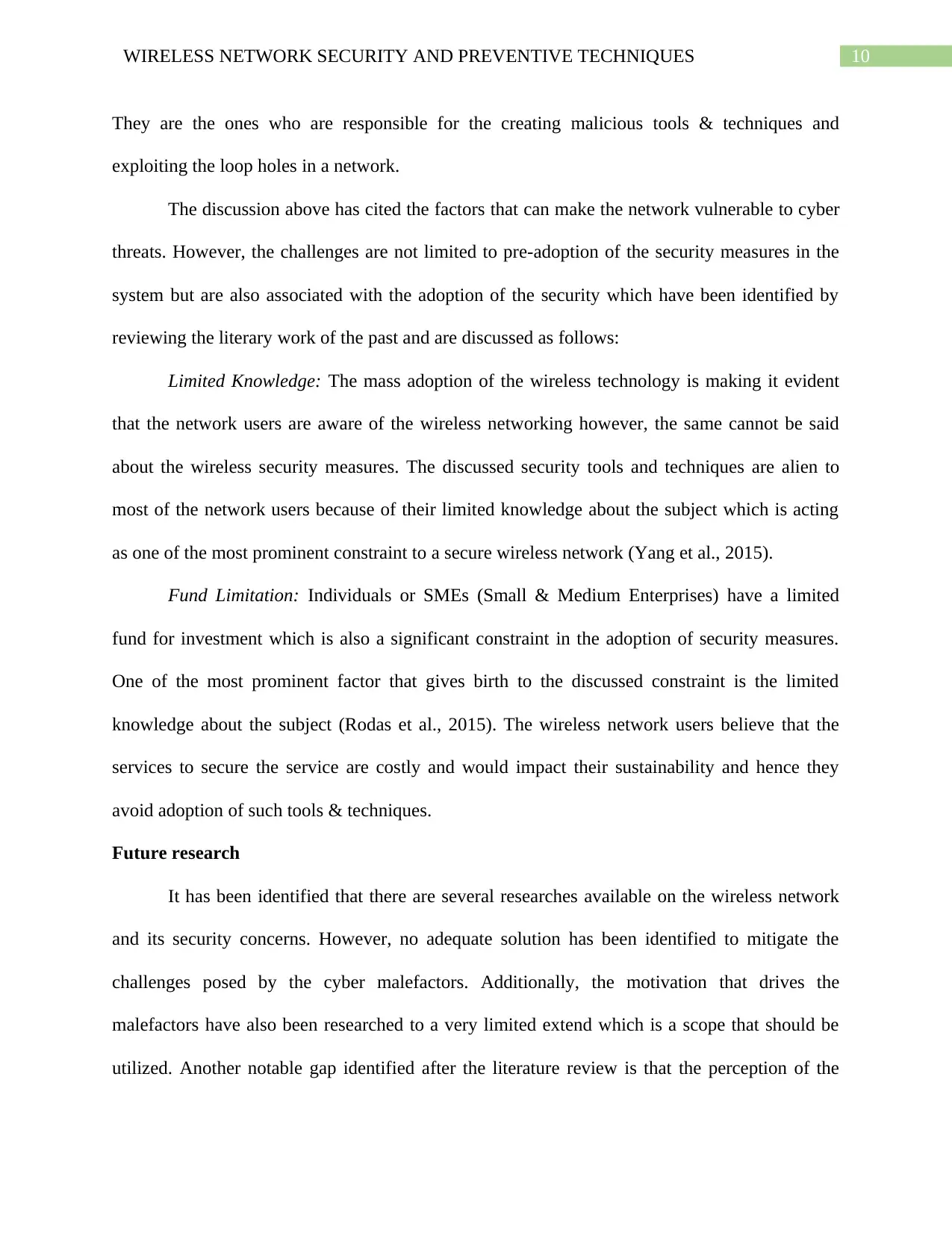
10WIRELESS NETWORK SECURITY AND PREVENTIVE TECHNIQUES
They are the ones who are responsible for the creating malicious tools & techniques and
exploiting the loop holes in a network.
The discussion above has cited the factors that can make the network vulnerable to cyber
threats. However, the challenges are not limited to pre-adoption of the security measures in the
system but are also associated with the adoption of the security which have been identified by
reviewing the literary work of the past and are discussed as follows:
Limited Knowledge: The mass adoption of the wireless technology is making it evident
that the network users are aware of the wireless networking however, the same cannot be said
about the wireless security measures. The discussed security tools and techniques are alien to
most of the network users because of their limited knowledge about the subject which is acting
as one of the most prominent constraint to a secure wireless network (Yang et al., 2015).
Fund Limitation: Individuals or SMEs (Small & Medium Enterprises) have a limited
fund for investment which is also a significant constraint in the adoption of security measures.
One of the most prominent factor that gives birth to the discussed constraint is the limited
knowledge about the subject (Rodas et al., 2015). The wireless network users believe that the
services to secure the service are costly and would impact their sustainability and hence they
avoid adoption of such tools & techniques.
Future research
It has been identified that there are several researches available on the wireless network
and its security concerns. However, no adequate solution has been identified to mitigate the
challenges posed by the cyber malefactors. Additionally, the motivation that drives the
malefactors have also been researched to a very limited extend which is a scope that should be
utilized. Another notable gap identified after the literature review is that the perception of the
They are the ones who are responsible for the creating malicious tools & techniques and
exploiting the loop holes in a network.
The discussion above has cited the factors that can make the network vulnerable to cyber
threats. However, the challenges are not limited to pre-adoption of the security measures in the
system but are also associated with the adoption of the security which have been identified by
reviewing the literary work of the past and are discussed as follows:
Limited Knowledge: The mass adoption of the wireless technology is making it evident
that the network users are aware of the wireless networking however, the same cannot be said
about the wireless security measures. The discussed security tools and techniques are alien to
most of the network users because of their limited knowledge about the subject which is acting
as one of the most prominent constraint to a secure wireless network (Yang et al., 2015).
Fund Limitation: Individuals or SMEs (Small & Medium Enterprises) have a limited
fund for investment which is also a significant constraint in the adoption of security measures.
One of the most prominent factor that gives birth to the discussed constraint is the limited
knowledge about the subject (Rodas et al., 2015). The wireless network users believe that the
services to secure the service are costly and would impact their sustainability and hence they
avoid adoption of such tools & techniques.
Future research
It has been identified that there are several researches available on the wireless network
and its security concerns. However, no adequate solution has been identified to mitigate the
challenges posed by the cyber malefactors. Additionally, the motivation that drives the
malefactors have also been researched to a very limited extend which is a scope that should be
utilized. Another notable gap identified after the literature review is that the perception of the
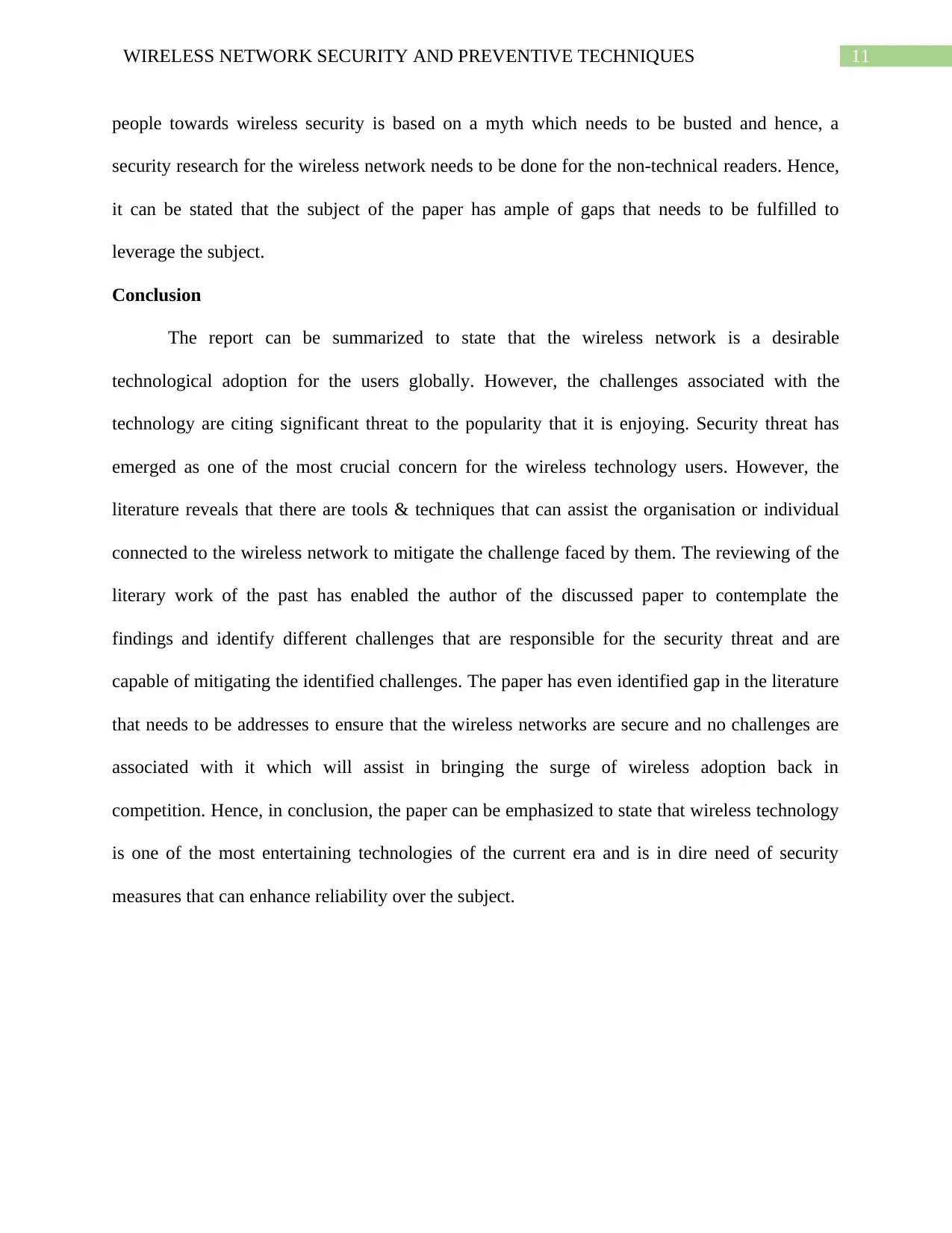
11WIRELESS NETWORK SECURITY AND PREVENTIVE TECHNIQUES
people towards wireless security is based on a myth which needs to be busted and hence, a
security research for the wireless network needs to be done for the non-technical readers. Hence,
it can be stated that the subject of the paper has ample of gaps that needs to be fulfilled to
leverage the subject.
Conclusion
The report can be summarized to state that the wireless network is a desirable
technological adoption for the users globally. However, the challenges associated with the
technology are citing significant threat to the popularity that it is enjoying. Security threat has
emerged as one of the most crucial concern for the wireless technology users. However, the
literature reveals that there are tools & techniques that can assist the organisation or individual
connected to the wireless network to mitigate the challenge faced by them. The reviewing of the
literary work of the past has enabled the author of the discussed paper to contemplate the
findings and identify different challenges that are responsible for the security threat and are
capable of mitigating the identified challenges. The paper has even identified gap in the literature
that needs to be addresses to ensure that the wireless networks are secure and no challenges are
associated with it which will assist in bringing the surge of wireless adoption back in
competition. Hence, in conclusion, the paper can be emphasized to state that wireless technology
is one of the most entertaining technologies of the current era and is in dire need of security
measures that can enhance reliability over the subject.
people towards wireless security is based on a myth which needs to be busted and hence, a
security research for the wireless network needs to be done for the non-technical readers. Hence,
it can be stated that the subject of the paper has ample of gaps that needs to be fulfilled to
leverage the subject.
Conclusion
The report can be summarized to state that the wireless network is a desirable
technological adoption for the users globally. However, the challenges associated with the
technology are citing significant threat to the popularity that it is enjoying. Security threat has
emerged as one of the most crucial concern for the wireless technology users. However, the
literature reveals that there are tools & techniques that can assist the organisation or individual
connected to the wireless network to mitigate the challenge faced by them. The reviewing of the
literary work of the past has enabled the author of the discussed paper to contemplate the
findings and identify different challenges that are responsible for the security threat and are
capable of mitigating the identified challenges. The paper has even identified gap in the literature
that needs to be addresses to ensure that the wireless networks are secure and no challenges are
associated with it which will assist in bringing the surge of wireless adoption back in
competition. Hence, in conclusion, the paper can be emphasized to state that wireless technology
is one of the most entertaining technologies of the current era and is in dire need of security
measures that can enhance reliability over the subject.
⊘ This is a preview!⊘
Do you want full access?
Subscribe today to unlock all pages.

Trusted by 1+ million students worldwide
1 out of 14
Related Documents
Your All-in-One AI-Powered Toolkit for Academic Success.
+13062052269
info@desklib.com
Available 24*7 on WhatsApp / Email
![[object Object]](/_next/static/media/star-bottom.7253800d.svg)
Unlock your academic potential
Copyright © 2020–2025 A2Z Services. All Rights Reserved. Developed and managed by ZUCOL.




